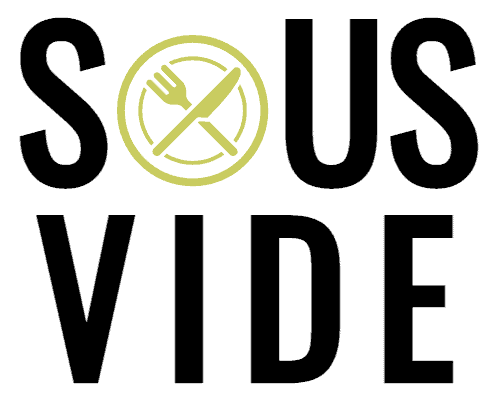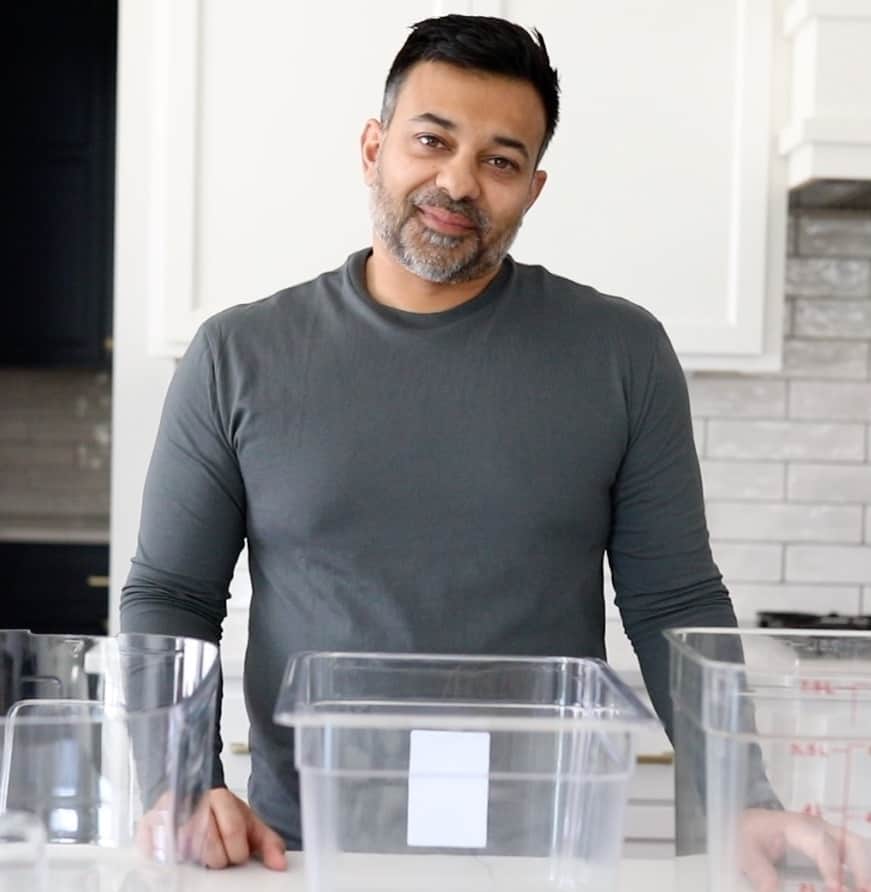Seeking a way to simplify your home cooking without resorting to nuking your food in the microwave? Enter the slow cooker vs sous vide machine debate.
Crucial to the debate, the crock-pot was invented out of a necessity for convenience while the sous vide cooker was invented for precision and quality.
In this article we’ll walk through the benefits and drawbacks of each to help you decide which is best for you.
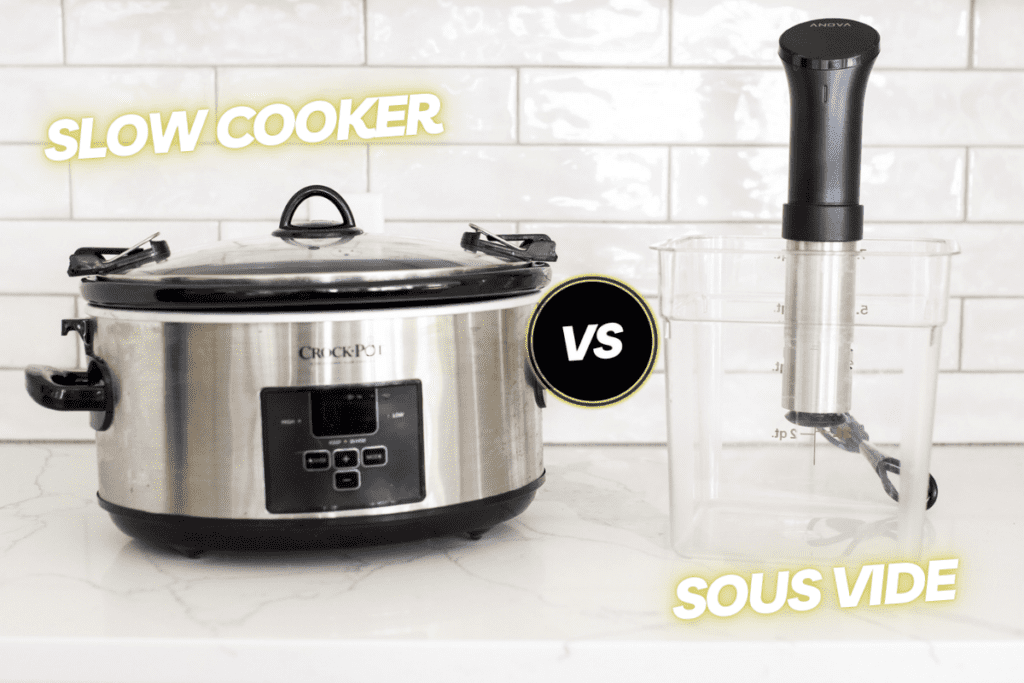
Top Sous Vide is a participant in the Amazon Services LLC Associates Program, an affiliate advertising program. This post may include affiliate links which means I may earn a small commission if you shop using the links below at no additional cost to you.
Table of Contents
What is a Slow Cooker and How Does It Work?
Slow Cooker History
The history of the slow cooker is perhaps most telling of how it can help modern day home cooks. Slow cookers were inspired by Jewish families in the 18th century that would use the residual heat of the town bakery to create a stew in anticipation of the Sabbath (day of rest).
That inspiration led to the modern slow cooker being invented in the 1930s (commercialized in the 1950s) as a means of preparing a meal for Sabbath dinner under kosher law. Thereafter, they became popularized to the home kitchens of the masses during the 1970s, under a new marketing name – Crock-Pot.
The promise of the Crock-Pot: the conveniences of a one pot meal with a set and forget it approach.
Slow Cooker Mechanics
A slow cooker cooks very similarly to a stovetop pot. That is, the base heats and cooks the food from below while the heat radiates outwards on all sides, cooking food placed inside it.
A slow cooker works by having an electric heating element at the base of the machine that plugs into the power outlet. Insert food in a cooking pot/vessel made of porcelain or ceramic. The food cooks in the vessel as the slow cooker warms up from the bottom. The vessel is removable from a stainless steel housing on newer models to make clean up easier.
Slow Cooker Settings
The advantage with a slow cooker is a more hands-off approach to cooking that functions the same as a pot on the stovetop. There are typically three temperature settings: low, high, and warm.
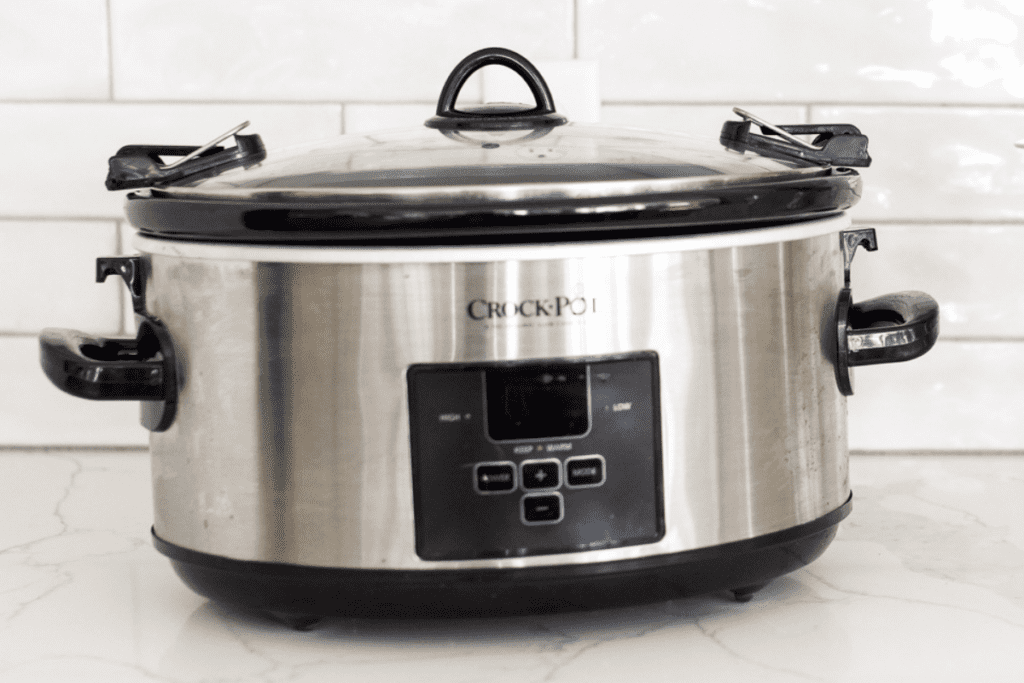
The heat on the bottom of the slow cooker radiates through the porcelain or ceramic vessel, and cooks food with a constant rate of heat.
A lower temperature setting is ideal for foods that can benefit from cooking for a long time, such as tough cuts of meat; The meat tenderizes over time while cooked at low temperatures.
A high heat setting cuts the time needed (in roughly half) to prepare foods. This setting is ideal for foods such as sauces and dips, which don’t suffer from high temperature cooking.
Modern slow cookers offer convenience in a number of ways. For instance, they come with programmable settings so you can set the temperature and amount of time without fuss. When the cooking cycle completes, it automatically switches to “keep warm” mode.
What slow cookers offer in convenience, they lack in precision. The temperature in the slow cooker is a function of many things, among them how full it is and how much liquid is in the recipe. Above all, convenience in preparation is the priority over quality of output when using a slow cooker (aka crock pot).
Slow Cooker Benefits
1. Easy to Use
Slow cookers are really simple cooking appliances. Any home chef can use it. Add your ingredients, turn it on, and leave it to finish cooking. No need to continuously monitor it.
2. Complete Meal
Veggies can cook along with meat to create a balanced, nutritious meal
3. Food Safety
A slow cooker’s low heat setting of ~170 degrees is above the 140 degrees needed to kill bacteria and pathogens.
4. Easy Cleanup
With a slow cooker, you only have the one non-stick, inner pot to clean. No more cleaning multiple pots and pans.
5. Energy Efficient
Slow cookers use are modest consumers of electricity
Slow Cooker Cons
1. There’s no one-size fits all option.
You’ll need to buy different sizes of slow cookers if you want to cook more or less food depending on how many people you’re cooking for.
2. Slow cookers are vulnerable to overcooking.
Overcooking can yield dried out meat and mushy vegetables
3. Meal planning in advance is necessary.
There are no recipes to prepare meals quickly in a slow cooker.
Slow cookers and Crock-Pots have endured as one of the most popular home cooking tools. They come in a variety of styles and the functions are even integrated into the Instant Pot, a multi-function pressure cooker that also slow cooks.
What is Sous Vide and How Does It Work?
If you’re new to this site, sous vide (pronounced “soo-veed”) is a French term that literally means “under vacuum”.
*Learn how to pronounce sous vide here!
In the sous vide method, you seal food in vacuum bags (plastic bag with all the air removed) and immerse them in a vessel of water.
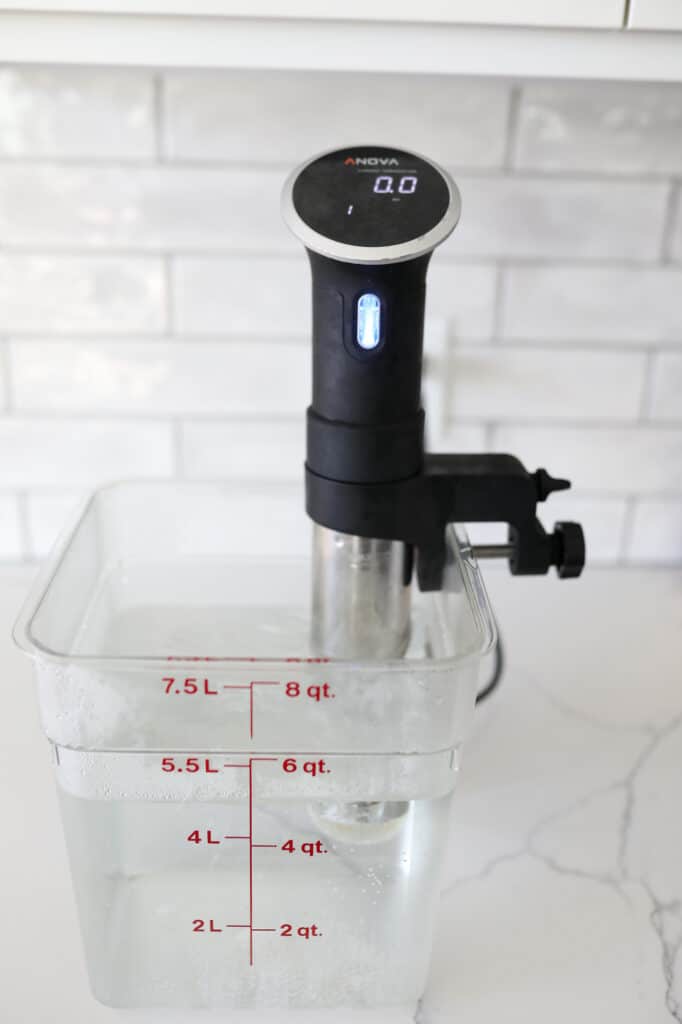
The water heats via a sous vide immersion circulator to the precise temperature set by the cook. The idea here is to set and maintain the temperature of the hot water bath to the precise internal temperature you prefer the food.
That is, if you enjoy your steak medium rare, set the machine temperature to 129 degrees Fahrenheit and walk away.
The sous vide method has long been a preferred option of professional chefs and more recently has become available and popular with home cooks too for its ability to produce very consistent results conveniently.
- Related Article: Why Sous Vide? Top 17 Reasons to Cook Sous Vide
Sous Vide Benefits
1. Precise Temperature Control
No more overcooking or undercooking your food, especially when it comes to your steaks, chicken, fish and other protein. You set your desired temperature and the sous vide machine does the rest, cooking your food to an exact temperature for your set amount of time.
2. Consistent Results
Your food cooks the same every time, because the temperature and timing are precisely controlled throughout the cooking process
3. Easy to Use
Set it and forget it. No need to monitor the sous vide container or pot. Set your temperature and time, and come back to perfectly cooked food.
4. Smart Machines
Ability to program and monitor cooking time and exact temperature remotely (e.g. while at work) via phone is a common feature
5. Flavorful Food
All the flavors are sealed within the sous vide bags, so you don’t need to worry about losing any of the food’s flavors while cooking. Cooking at the ideal low temperatures preserves a greater amount of vitamins and nutrients.
6. Waste Reduction
Steaks and other foods can lose up to 40% of its volume with traditional cooking methods, due to the food drying out. Sous vide minimizes lost volume.
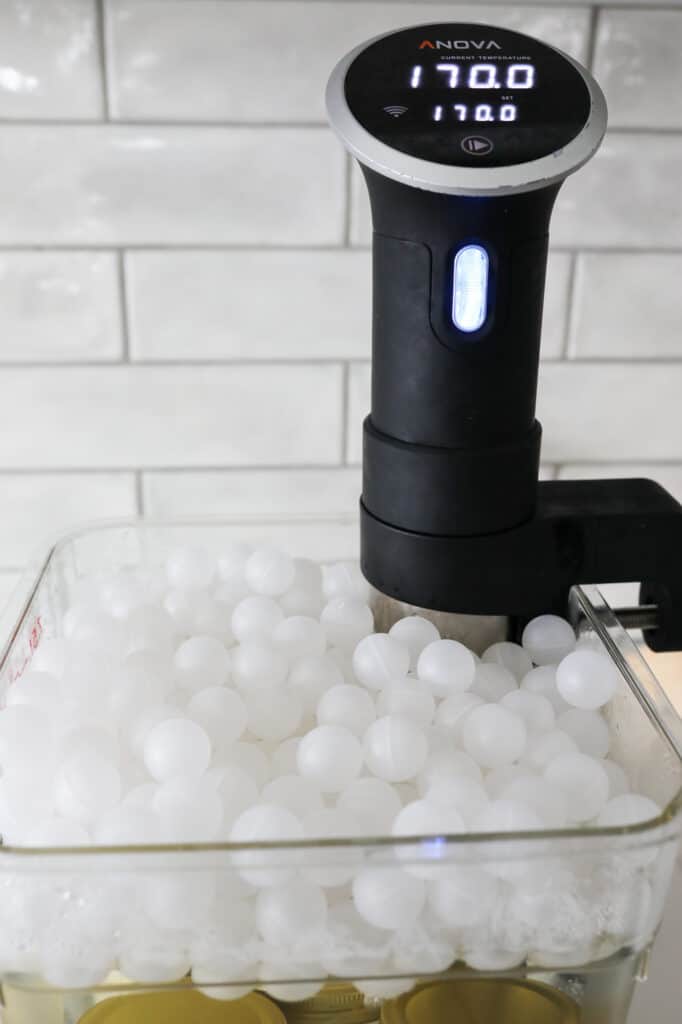
7. Quantity Flexibility
Sous vide cookers give you the ability to cook more or less food easily with different sized sous vide containers. So, if you have guests coming over, just find a larger container. Read more about what size sous vide containers are ideal for number of people eating.
8. Easy Cleanup
Toss the bag and dump or re-use the water. Note, resealable bags are also available.
There are many great sous vide recipes on the website to get you sous vide cooking quickly.
Read more about cleaning sous vide cookers.
Sous Vide Cons
Limited to one temperature.
You’re limited to one temperature for your foods; your meat and vegetables are ideal at different temperatures, so you will have to cook them separately.
Improper use can effect results.
An improper setup can lead to food being cooked unevenly or ruined; e.g. leaky bags or bags with air in them.
Similarities and Differences
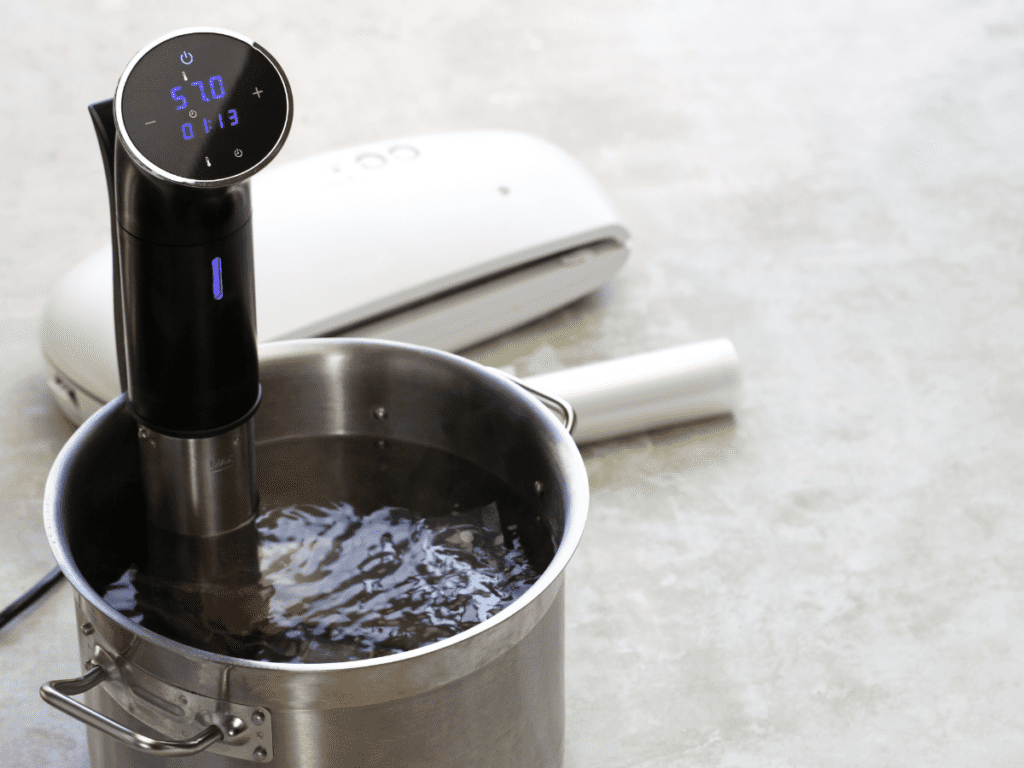
Sous Vide and Slow Cooker Similarities
Both a sous vide circulator and a slow cooker use a versatile low and slow cooking technique that allow you to set it and forget while greatly reducing cleanup.
Sous Vide and Slow Cooker Differences
The slow cooker affords you the ability to cook well rounded meals in one go. The sous vide results are superior in quality and consistency, given it is precision based.
The sous vide is better for batch meal prep, given the use of a vacuum sealer.
Prepare your food in advance (e.g. marinated chicken breast or veggies with herbs) and vacuum seal it. The juices and nutrients are preserved and the life of the food is extended in the bag.
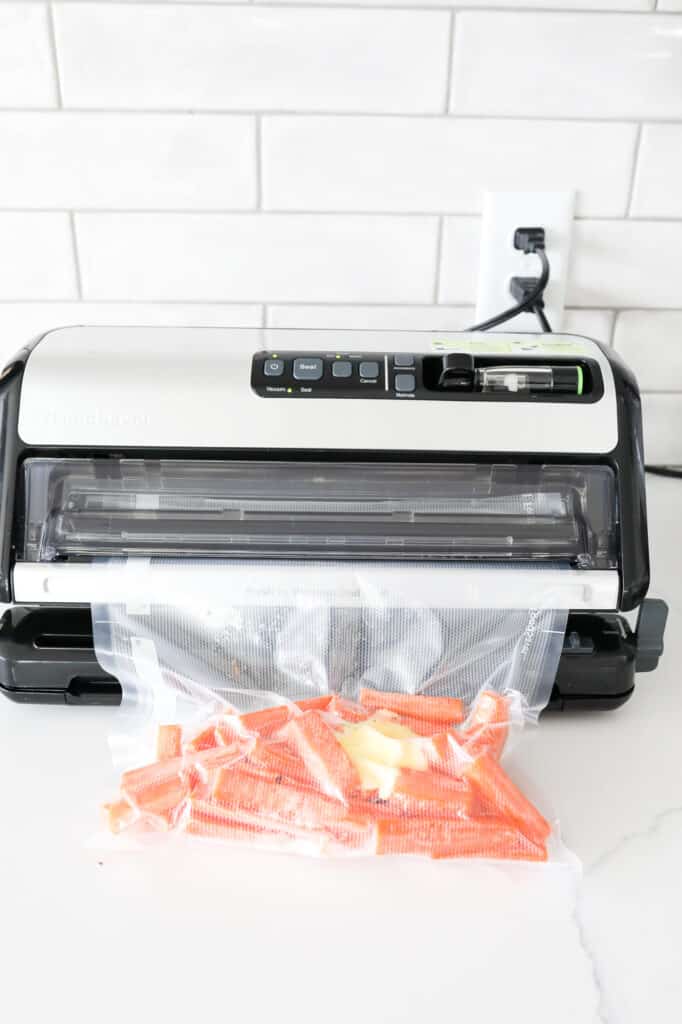
You can freeze the sealed food you’re not planning to eat immediately and sous vide it from its sealed frozen state when you choose to eat it.
Sous vide cookers are more flexible with food quantities too, because you can use them on different sized containers and pots for different amounts of food.
Final Thoughts on Sous Vide vs Slow Cooker
In conclusion, the best use cases are where the main difference lies, but both kitchen items bring a lot of convenience. Therefore, I’d own both if I could afford to and had the space. If space is a concern, the sous vide cooker is the better of the two options. Note, if you have already own an Instant Pot, you own a slow cooker (and more).
Here are some other comparisons of sous vide to other cooking methods and appliances:
